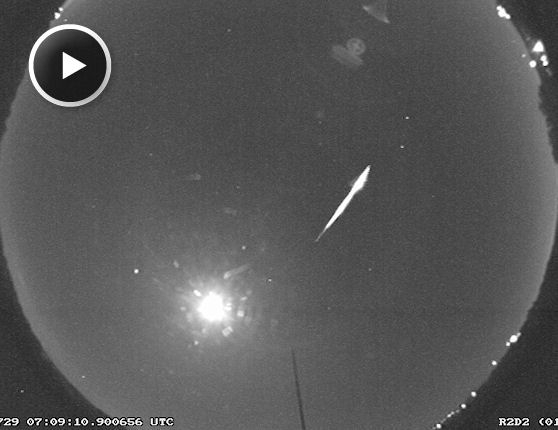NASA Tracks Meteor Fireballs With New Robot Cameras

NASA has a new network of smart cameras to keep a robotic vigil on the roughly 100 tons of meteoroids that slam into Earth every day.
As these fragments of space dust, gravel and rock enter the Earth's atmosphere they sometimes create bright fireballs or "shooting stars." Yet the question of where the meteoroids come from is largely unknown.
A meteor might originate in the asteroid belt between the orbits of Mars and Jupiter, in a comet's death throes, or as a piece of man-made space junk.
But NASA's new smart camera network is designed to solve that mystery. Researchers will use it to triangulate the fireballs' paths, and special software will then use the data to compute their orbits.
"If someone calls me and asks 'What was that?' I'll be able to tell them," said William Cooke, head of NASA's Meteoroid Environment Office, in a statement. "We'll have a record of every big meteoroid that enters the atmosphere over the certain parts of the U.S. Nothing will burn up in those skies without me knowing about it!"
Robot meteor hounds
Scientists have different names for space rocks depending on where they are. For example, small rocks and dust particles in space are meteoroids until they encounter Earth's atmosphere. If they burn up in a bright fireball or flash, they are a meteor. Any leftover pieces that actually reach the surface of the Earth are meteorites.
Breaking space news, the latest updates on rocket launches, skywatching events and more!
In other U.S. meteor networks, a person has to manually study all the cameras' data, and then calculate their orbits – a painstaking process to backtrack from the fireball to the original object. [Spectacular Leonid Meteor Shower Photos]
"With our network, our computers do it for us – and fast," said Cooke, who is based at NASA's Marshall Space Flight Center in Huntsville, Ala.
So far, the first three cameras in the network (each the size of a gumball machine) are already up and running. Cooke and his team hope to have 15 cameras deployed east of the Mississippi River soon.
Space rock investigation
Eventually, NASA plans to expand the new camera nationwide and is seeking out schools, science centers, and planetariums willing to host the cameras.
The instruments track meteoroids and their orbits, and provide data on meteor speed as a function of size. This will allow experts to calculate whether a fireball will plunge to Earth, and pinpoint the impact location fairly precisely.
"And when we collect the meteorite chunks, we'll know their source," Cooke said. "I could be holding a piece of Vesta in my hand. It would be like a free sample return mission!"
However, just knowing a meteoroid's path doesn't guarantee we'll be able to find it.
"Most meteorites fall in the ocean, lakes, forests, farmer's fields, or the Antarctic," said Rhiannon Blaauw, an assistant to Cooke. "And the majority of those meteorites will never be found. But our system will help us track down more of them."
Cooke had some tips for students and skywatchers hoping to see a meteor fireball on their own:
"Go out on a clear night, lie flat on your back, and look straight up. It will take 30 to 40 minutes for your eyes to become light adapted, so be patient," he said. "By looking straight up, you may catch meteor streaks with your peripheral vision too. You don't need any special equipment –just your eyes."
If anyone does spot a meteor, they can check this NASA website to see if it the space agency identified its origins: http://fireballs.ndc.nasa.gov/
Follow SPACE.com for the latest in space science and exploration news on Twitter @Spacedotcom and on Facebook.
Join our Space Forums to keep talking space on the latest missions, night sky and more! And if you have a news tip, correction or comment, let us know at: community@space.com.

Space.com is the premier source of space exploration, innovation and astronomy news, chronicling (and celebrating) humanity's ongoing expansion across the final frontier. Originally founded in 1999, Space.com is, and always has been, the passion of writers and editors who are space fans and also trained journalists. Our current news team consists of Editor-in-Chief Tariq Malik; Editor Hanneke Weitering, Senior Space Writer Mike Wall; Senior Writer Meghan Bartels; Senior Writer Chelsea Gohd, Senior Writer Tereza Pultarova and Staff Writer Alexander Cox, focusing on e-commerce. Senior Producer Steve Spaleta oversees our space videos, with Diana Whitcroft as our Social Media Editor.

